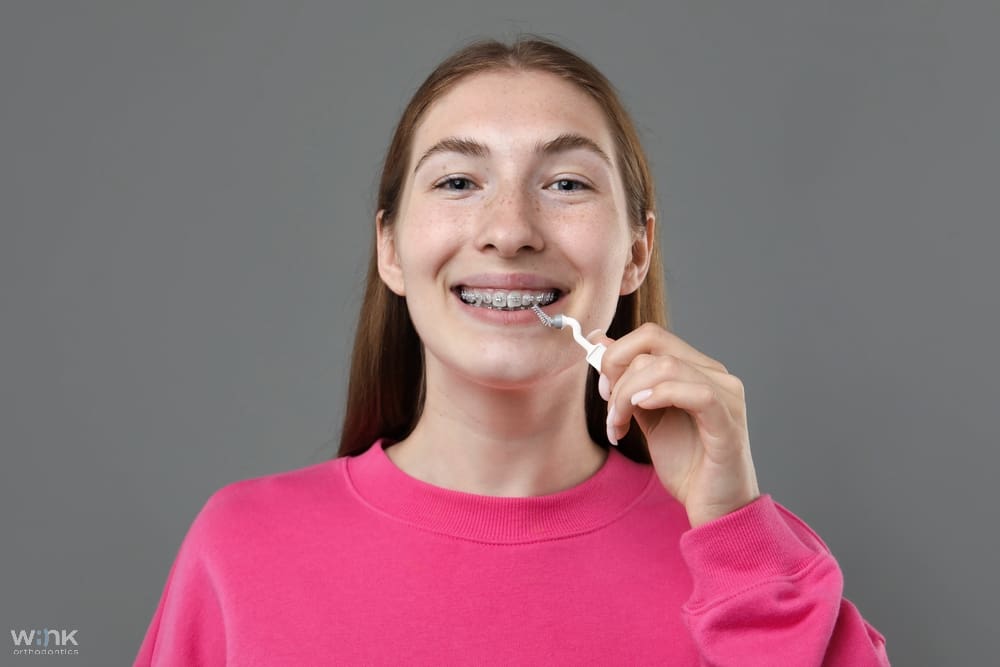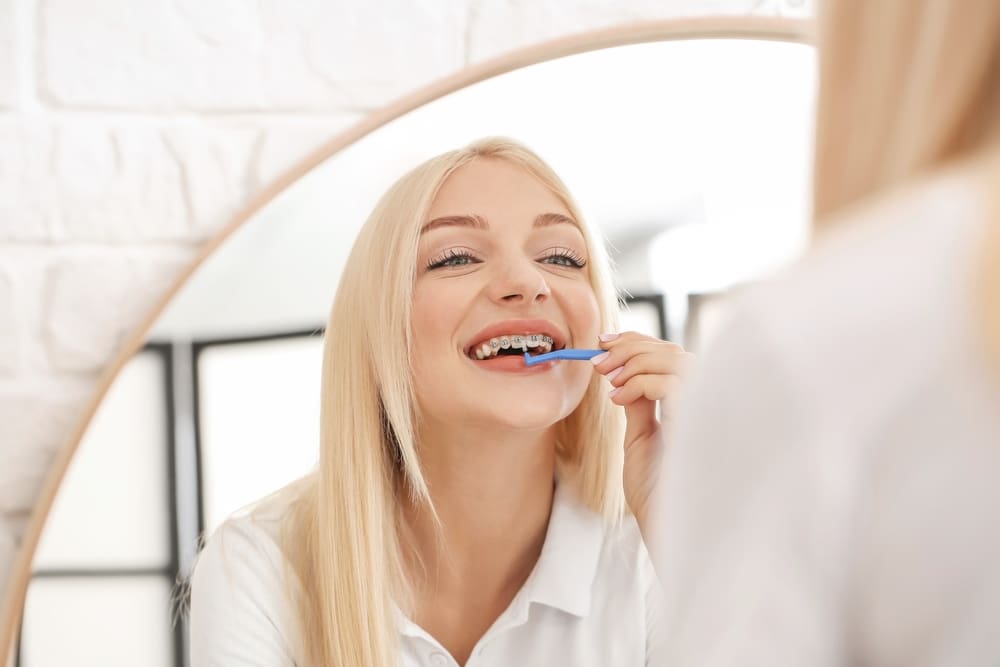Trying to figure out how to floss with braces in Prosper and Colleyville, TX? Braces can make it harder to keep your teeth clean. Alignment issues, along with wires and brackets, can feel like obstacles at first. But with the right flossing tools and techniques, the process gets much easier. A consistent oral hygiene routine is key to keeping your teeth and gums healthy during orthodontic care.
Keep reading to see how the right tools and methods can make flossing with braces fast and simple.

Why Flossing with Braces Matters
Braces help straighten and align your teeth, but they also make cleaning more challenging. Food particles and plaque collect around wires and brackets easily. If not removed, these can harden into tartar, leading to tooth decay, gum irritation, or even gum disease. Using proper flossing methods is important because brushing alone can’t reach all the small spaces. Flossing promotes comfort during treatment and ensures that your progress stays on track.
Essential Flossing Tools for Braces
The right tools can make a big difference when it comes to flossing with braces. Here are the tools orthodontists recommend:
Floss Threaders
A floss threader works like a sewing needle. It helps guide floss under your wires, making it easier to clean between your teeth and around brackets. These are affordable and easy to use, and many orthodontic clinics provide them to their patients.
Water Flossers
Water flossers spray water to remove plaque and food particles. They are an excellent choice if you have sensitive gums or struggle with traditional dental floss.
Superfloss
Superfloss includes stiffened ends that make it easier to thread between your braces. It also has soft, spongy strands that are ideal for clearing plaque along your gumline. This tool is especially useful for people with braces or other orthodontic appliances.
Interdental Brushes
An interdental brush (also called a proxabrush) is a small brush designed to clean between teeth. It can fit into tight spaces that floss might miss, making it a great option for areas near brackets and wires.
Floss Picks
Floss picks have a small handle and pre-threaded floss. These are perfect for quick flossing sessions, especially for beginners or anyone who finds string floss frustrating to use.
Investing in high-quality tools designed for braces makes the process faster and more efficient. For best results, follow the instructions provided by your orthodontist.
Where to Get Flossing Tools
You can find these essential flossing tools, like floss threaders, water flossers, and interdental brushes, at most pharmacies or online. Many orthodontic clinics, like Wink Orthodontics in Prosper and Colleyville, TX, can provide starter kits that include everything you need to begin a proper oral hygiene routine.
Step-by-Step Guide to Flossing with Braces
Follow these steps to keep your teeth and gums healthy while wearing braces:
Step 1: Prepare the Floss
Start by cutting about 18 inches of floss. Use a floss threader to guide the floss under the wire, near the gumline. Be sure to use a clean section of floss for each tooth.
Step 2: Clean Each Tooth
Wrap the floss around one tooth in the shape of a “C.” Gently move the floss up and down along the gumline and sides of the tooth. Avoid using rough sawing motions, as these can irritate your gums.
Step 3: Focus on Hard-to-Reach Areas
For tougher spots, use a water flosser or interdental brushes to target areas like molars or the back teeth. Water flossers are especially helpful for cleaning around brackets and wires thoroughly. According to Dr. Kayla Carr, a professional orthodontist in Fairview, TN, combining a water flosser with interdental brushes can provide a thorough clean for back teeth and other spots that are tough to reach.
Step 4: Brush After Flossing
Once you’ve finished flossing, brush your teeth with a soft-bristle toothbrush and fluoride toothpaste. Pay attention to the areas around wires and brackets. Finish your routine with a fluoride mouthwash to strengthen your enamel and fight bacteria.
Flossing Methods for Different Types of Braces
The type of braces you have can determine the best flossing technique:
- Metal Braces: Spend extra time threading floss under the wires.
- Clear Braces: Use gentle motions to avoid damaging delicate brackets.
- Lingual Braces: These are placed behind your teeth, so a water flosser or interdental brush may work better.
- Self-Ligating Braces: With fewer parts, these require less threading but still need a thorough cleaning routine.
Common Challenges and How to Solve Them
Sensitive or Irritated Gums
If your gums feel sore or bleed during flossing, rinse with warm saltwater after each session. Be gentle while flossing, and over time, your gums will become healthier and less sensitive.
Trouble Reaching Tight Spaces
Use tools like proxy brushes or interdental brushes for tight and hard-to-reach areas. They fit into small gaps and help clear out plaque quickly.
Frustration with Traditional Floss
Don’t like threading floss between your teeth? Try pre-threaded floss picks or invest in a water flosser. These options make your cleaning routine easier and less time-consuming.
Post-Braces Oral Hygiene
After your braces are removed, continue practicing good oral hygiene habits. Here’s a post-treatment routine to follow:
- Clean Your Retainer: Rinse and brush your retainer daily to prevent the buildup of plaque and bacteria.
- Floss Every Day: Even without braces, flossing helps prevent gum disease and tooth decay.
- Brush Carefully: Brush for two minutes twice a day. Use fluoride toothpaste to strengthen your teeth and protect against cavities.

Why Wink Orthodontics Recommends Flossing
At Wink Orthodontics, we focus on making your orthodontic care successful and stress-free. Proper oral hygiene is a key part of your treatment. Here’s what we provide to help patients like you:
- Personalized Tips: Find out the best flossing techniques for your braces.
- Starter Kits: Get essential tools, such as floss threaders, proxabrushes, and water flossers.
- Expert Guidance: Our team will help you manage problems like gum irritation and plaque buildup while improving your overall dental hygiene.
Start Flossing Today
Flossing doesn’t have to be difficult, even with braces! With the right tools, techniques, and guidance, you can maintain excellent oral health throughout your treatment. If you’re struggling with your flossing routine, talk to the experts at Wink Orthodontics in Prosper and Colleyville, TX. Schedule your appointment today, and our team can help you simplify your daily hygiene and keep your smile clean and bright.
About The Authors
Dr. Mo Zainal – Orthodontist in Prosper and Colleyville, CA
Dr. Kayla Carr – Orthodontist in Fairview, TN
Frequently Asked Questions
Is it okay to skip one day of flossing with braces?
It’s best to floss every day, but skipping one day won’t ruin your teeth. Everyone has busy or tired days, and that’s okay, just don’t make it a habit. Braces can trap food and plaque easily, so daily flossing helps keep your teeth and gums healthy. If you miss a day, floss well the next time to stay on track. A little effort each day keeps your smile in great shape!
Can dentists tell if you don’t floss?
Yes, dentists can tell if you haven’t been flossing. When you skip flossing, plaque builds up between your teeth and makes your gums red, puffy, or likely to bleed. Your dentist might also spot tartar or small cavities between teeth. Don’t worry, they’re not judging you! Dentists just want to help you keep your smile clean and healthy.
How can I tell if I’m flossing correctly?
You’re flossing correctly if you feel light pressure as the floss moves between your teeth. Wrap it around each tooth in a C-shape and slide it up and down gently. Avoid snapping the floss or sawing it side to side. If you hear a squeaky sound, that means your teeth are clean. A bit of gum tenderness is normal at first, but bleeding should lessen as you keep flossing.

